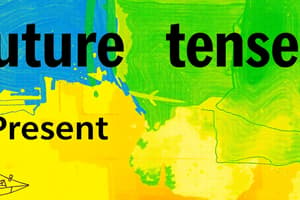Podcast
Questions and Answers
What is the structure of the series 'Future Doctors Mind Maps'?
What is the structure of the series 'Future Doctors Mind Maps'?
- It delves into the different parts of androshiyam, including the filament and its connection to the flower's body
- It is structured with two rooms, each containing two cup-like structures known as 'dai thik' and the fertile part with sporangi, meiosis, spores, and pollen grains
- It explores the concept of androshiyam and discusses its proximal and distal ends
- It converts each line of NCERT into a diagram to create a comprehensive mental map (correct)
What is the main purpose of the 'Future Doctors Mind Maps' series?
What is the main purpose of the 'Future Doctors Mind Maps' series?
- To help students effectively remember NCERT content (correct)
- To discuss the connection between androshiyam and gyanoshiam
- To provide a detailed explanation of sexual reproduction
- To guide students through medical college entrance exams
What does the series 'Future Doctors Mind Maps' discuss regarding the fertile part of the flower?
What does the series 'Future Doctors Mind Maps' discuss regarding the fertile part of the flower?
- It discusses the concept of androshiyam and its proximal and distal ends
- It contains sporangi and undergoes meiosis to form spores and convert into pollen grains (correct)
- It explores the different parts of androshiyam, including the filament and its connection to the flower's body
- It converts each line of NCERT into a diagram to create a comprehensive mental map
What is the connection between androshiyam and the structures it is connected to?
What is the connection between androshiyam and the structures it is connected to?
What is the result of the combination of two gametes in sexual reproduction?
What is the result of the combination of two gametes in sexual reproduction?
Where is sexual reproduction most common among eukaryotes?
Where is sexual reproduction most common among eukaryotes?
What process in bacteria may be considered analogous to sexual reproduction?
What process in bacteria may be considered analogous to sexual reproduction?
What is the result of meiosis in eukaryotes?
What is the result of meiosis in eukaryotes?
Where does sexual reproduction not occur?
Where does sexual reproduction not occur?
Flashcards are hidden until you start studying
Study Notes
Understanding the "Future Doctors Mind Maps" Series
- "Future Doctors Mind Maps" is a series designed to help students remember NCERT content effectively.
- Students often struggle to recall NCERT content, hindering their progress in medical college entrance exams.
- The series aims to create a mind map of NCERT content that can guide students all the way to medical college.
- The series converts each line of NCERT into a diagram to create a comprehensive mental map.
- The series starts by discussing sexual reproduction and structures involved such as androshiyam and gyanoshiam.
- It explores the concept of androshiyam and discusses its proximal and distal ends.
- The series explains the connection between androshiyam and the structures it is connected to.
- It delves into the different parts of androshiyam, including the filament and its connection to the flower's body.
- The series discusses the fertile part of the flower, which contains sporangi and undergoes meiosis to form spores and convert into pollen grains.
- The series is structured with two rooms, each containing two cup-like structures known as "dai thik" and the fertile part with sporangi, meiosis, spores, and pollen grains.
Studying That Suits You
Use AI to generate personalized quizzes and flashcards to suit your learning preferences.




